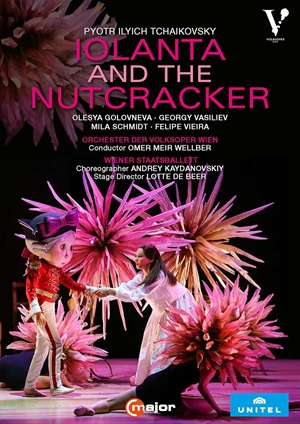
Pyotr Tchaikovsky (1840-1893)
Iolanta and The Nutcracker
Iolanta, opera in one act (1892)
The Nutcracker, ballet (1892)
Vienna State Ballet, Andrey Kaydanovskiy (choreography), Orchester der Volksoper Wien/Omer Meir Wellber, Lotte de Beer (stage direction)
rec. 2022, Volksoper, Vienna, Austria
Booklet in English, German and French
Reviewed in surround sound
C Major 765108 DVD [97]
When Tchaikovsky’s The Nutcracker ballet was first danced in Saint Petersburg in 1892, it was part of a double bill with his one-act opera Iolanta. The Volksoper Wien and the Wiener Staatsballett perform the same double bill in one evening – but as a unified whole, which fuses much of the opera with items from the ballet. This requires excisions. Each score usually runs for about an hour and a half, while this combination occupies us for a mere 97 minutes. This is not a substitute for two works, then, but a new hybrid work on its own. The opening credits call it a “musical theatre piece”.
There is artistic logic to the enterprise. The opera concerns the daughter of King René, Iolanta. She is blind, but this is a secret the King commands must be kept from her. She lives apart from the world, unaware she is a Princess, and spends her time daydreaming in a beautiful garden. Young Count Vaudémont loves her, and when all obstacles have been overcome, Iolanta gains her sight and is betrothed to the Count. In The Nutcracker,of course, Clara, the leading dancer, is a girl who also inhabits a dream world.
Stage director Lotte de Beer and music director Omer Meir Wellber focus on the opera, and deploy the ballet as Iolanta’s dream world. So, the cast has three Iolantas, a singer, a dancer, and Iolanta as a young girl. The opera score dominates the playing time. Each of the score’s nine numbers is represented, for about two-thirds of the whole. Indeed, one could think of this as a somewhat unusual version of the opera, but in no sense a version of the ballet.
The items from the ballet are selected for their fitness in the dreamt story line, or perhaps for their musical charm. The Waltz of the Flowers and the Dance of the Sugar Plum Fairy make an appearance in Part One, whereas in the full ballet score they occur later in the Second Act. Part One closes with the superb Nutcracker pas-de-deux, and Part Two has only about twelve minutes from the ballet, but they are delightfully staged and danced. They are not only stand-alone items. Some dancing also occurs during scenes from the opera. So, there is integration as well as interpolation.
The singing is as accomplished as the dancing, and all the voices would serve well as leads in a performance of Iolanta alone. The costumes are modern-day: King René in a smart suit and tie, the Doctor in a medical white coat, and almost everyone else in casual attire. The dancers in the dream sequences mostly have traditional Nutcracker costumes for mice, soldiers and the rest. Lotte de Beer stages the key moments of the opera very effectively. Especially poignant is the scene in which Vaudémont – exasperated that Iolanta does not give him a red rose as requested but offers another white rose – realises that she is blind. The orchestra is excellent under Omer Meir Wellber, and the video and sound are very good.
Iolanta and The Nutcracker also appear together on a BelAir Classiques issue (one Blu-ray disc or two DVDs; review). The complete works are given separately. First comes the opera, 93 minutes, then the ballet, 95 minutes. It apparently becomes clear that the opera was performed as a birthday present for the ballet’s lead, the young Clara, but there is no interweaving of the music. The Vienna Volksoper’s radically different conception makes for an intriguing recording of a very interesting production.
Roy Westbrook
Help us financially by purchasing from



Cast
Olesya Golovneva (Iolanta singer)
Mila Schmidt (Iolanta dancer)
Sofia Božović (Iolanta as a girl)
Stefan Cerny ( King René)
Georgy Vasiliev (Count Vaudémont)
Andrei Bondarenko (Robert)
Felipe Vieira (Prince Nutcracker)
Christopher Krasnansky (Prince Nutcracker as a boy)
Szymon Komasa (Ibn-Hakia, a physician)
David Kerber (Alméric, armour-bearer to King René)
Kasushi Hirano (Bertrand, doorkeeper of the castle)
Stephanie Maitland (Marta, Iolanta’s nursemaid)
Anita Götz (Brigitta, Iolanta’s friend)
Annelie Sophie Müller (Laura, Iolanta’s friend)
Olivia Poropat, Keisuke Nejime (two mice)
Sarah Branch (a rabbit)
Verena Horsky (stilt walker)
Production staff
Stage design: Katrin Lea Tag
Costume design: Jorine van Beek
Lighting design: Alex brok
Dramatic advisors: Peter Te Nuyl, Anne do Paço
Video director: Felix Breisach
Video details
Picture format: NTSC, 16:9
Sound: PCM Stereo, DTS 5.0
Region code: 0 (worldwide)
Sung in German
Subtitles: German, English, Korean, Japanese

















